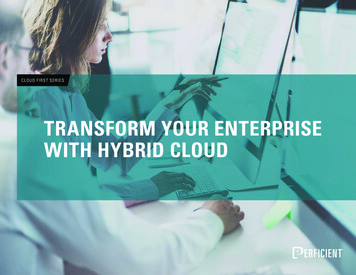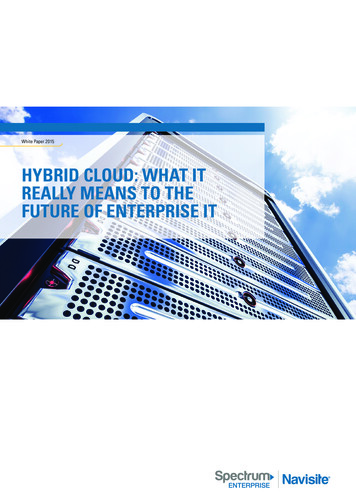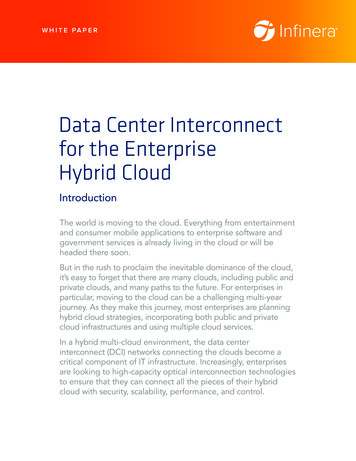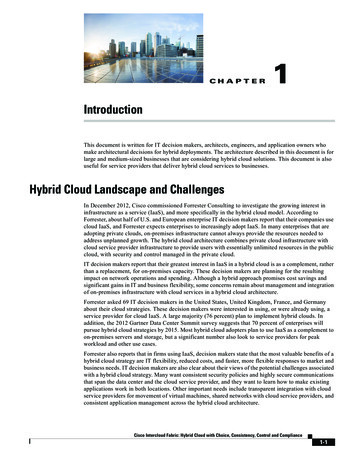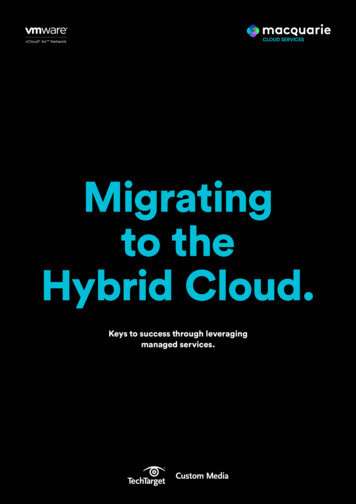
Transcription
CLOUD SERVICESMigratingto theHybrid Cloud.Keys to success through leveragingmanaged services.
2Migrating to the Hybrid CloudCLOUD SERVICESIntroduction.In IT today, all signs are pointingin one direction: to the cloud.By the end of the decade, nearly 70% of all enterprise IT spendingacross the globe will be for cloud-based offerings.1 In Australia,a hybrid IT strategy—incorporating a mix of on-premise andcolocated data centres with private and public cloud services—is emerging as the dominant model for IT transformation andmodernisation.Nearly 50% of IT decision-makers at midsize and large companies in Australiaare prioritising hybrid cloud over public or private cloud, according to asurvey conducted by Microsoft.2 These IT leaders are not planning to increaseinvestments in private- or public-only solutions, thereby reinforcing thedemand for a more integrated hybrid approach.“Adopting a hybrid cloud strategy is the next step in the journey fororganisations looking to take advantage of modern cloud computingcapabilities while continuing to manage their traditional assets,” the researchconcludes.As many business and IT leaders have already discovered, migrating tothe cloud can be a blessing. With a successful hybrid cloud migration,organisations can reduce costs, improve productivity, accelerate time tomarket and enable a tighter alignment of IT with business goals. In addition,contrary to prevailing wisdom, migrating to a hybrid cloud model canstrengthen security and regulatory compliance capabilities.But migrating to the cloud can also be a curse. Many companies have tried ago-it-alone strategy and learned the hard way that moving to the cloud can bea complicated, bet-your-business-type proposition. While some public cloudproviders would have you believe it’s as easy as purchasing storage or serviceson a credit card, the reality is far more complex, and the risks of makingmistakes are far more real, insidious and potentially damaging than IT or
3Migrating to the Hybrid CloudCLOUD SERVICESbusiness leaders may realise—potentially resulting in skyrocketing costs, poorapplication performance, increased downtime, product delays and undetectedsecurity gaps, among others.Today’s reality is that most organisations don’t have the personnel, expertise orexperience to navigate the cloud journey on their own. They need help. Helpin deciding which workloads and applications to put in the cloud—and when.Help in figuring out if a private, public or hybrid cloud model makes sense—and for which workloads. Help in planning, costing, architecting, scaling andsecuring the cloud environment. Help in choosing from among a plethora ofcloud service options: platform as a service (PaaS), infrastructure as a service(IaaS), software as a service (SaaS), disaster recovery as a service (DRaaS),backup as a service, managed hosting, data centre extension, dedicatedservers, virtual data centres, and more.What to do? Fortunately, there is a way to sort through the confusion andmaximise cloud benefits while minimising risk. For organisations of all sizesin Australia, the answer is to work with a knowledgeable and experiencedmanaged cloud services provider. The right services provider can guide yourorganisation each step of the way and tell you the plain truth about what thecloud can—and can’t—do for you. You can collaborate with the provider tobuild a plan that will inform which workloads and applications to put into thecloud; how to manage costs; how and when to roll out new services; howto manage security and compliance; how to make the most of your existingresources (both personnel and infrastructure); and how to address all of theother issues involved in ensuring a successful migration to the cloud.This e-book is designed to help IT and business leaders understand theexciting opportunities enabled by a successful migration to the cloud,particularly the hybrid cloud. We discuss the value hybrid cloud can bring toyour business, and the potential pitfalls involved in making the migration. Wealso answer questions you may have about cloud deployment models, costs,personnel, manageability, security and reliability. Finally, we examine thebenefits of working with a managed cloud services provider and explore thekey characteristics and capabilities to look for in a partner.This e-book isdesigned to help ITand business leadersunderstand theexciting opportunitiesenabled by asuccessful migration tothe cloud, particularlythe hybrid cloud.
4Migrating to the Hybrid CloudCLOUD SERVICESTable of contents.The Business Case for Hybrid Cloud. 5Lost in the Cloud: Ignorance is Not Bliss. 12 anaged Cloud Services: The Key to Reducing Risk andMGaining Competitive Edge. 15A Guide to Choosing the Right Cloud Partner. 17Conclusion. 20
5Migrating to the Hybrid CloudCLOUD SERVICESThe business case forHybrid Cloud.Why cloud?Why cloud, why now, and why is hybrid cloud emerging as thedominant deployment model?Let us count the ways. Cloud brings a new model to IT, one basedon the delivery of services rather than the delivery of technology.With cloud computing as the foundation for IT modernisation,organisations can reduce capital expenditures, lower total costof ownership, improve productivity, accelerate time to market,mitigate the risk of downtime, reduce IT complexity and use ITpersonnel far more strategically.Cloud enables organisations to leverage benefits such as resource pooling,elastic scalability and self-service provisioning to increase agility and improveresponsiveness to customer needs. Cloud provides a much more efficienttechnology platform for the critical IT initiatives of the modern era, such asbig data analytics, social networking, mobile applications and the Internetof Things. Cloud lowers risk and increases agility by introducing a highlyautomated approach to IT, with a simplified model for integrating a wide rangeof applications through application programming interfaces (APIs).In addition, cloud enables organisations to improve the performance andavailability of business-critical workloads, including databases, onlinetransaction processing systems, customer relationship management, humanresources, finance and others. By migrating these applications to the cloud,IT can modernise their underlying infrastructure, making it much faster andeasier to add new features and services to support important trends suchas mobility.
6Migrating to the Hybrid CloudCLOUD SERVICESWhy now?Aging legacy infrastructures with siloed data and applicationsare an impediment to progress, competitiveness and innovation.At the same time, companies must respond to the realitiesof a rapidly changing work environment driven by digitaltransformation. By the end of the decade, digital transformationwill “reshape the global economy,” according to IDC, with nearly75% of overall IT spending going toward technologies, includingcloud, that support these initiatives.3Organisations can’t afford to be left behind. Digital transformation hasdisrupted entire industries: Uber in transportation and Airbnb in travel are twowidely cited examples. But organisations in government, healthcare, financialservices, education, retail, manufacturing and other industries are just assusceptible to shifting business models and therefore must have an agile ITinfrastructure that can react quickly to changing market conditions.
7Migrating to the Hybrid CloudCLOUD SERVICESWhy hybrid cloud?Another important aspect of digital transformation is thechanging nature of workforces and customers. We areliving in a world where mobility is increasingly importantand a new generation of workers and customers has anew set of expectations. This change is often expressedas “IT consumerisation,” whereby users take theirexperiences and expectations from the consumer worldand apply them to the business world. It means IT teamsmust deliver accelerated application developmentcycles, mobile-native applications, and new user andcustomer experiences through distributed services andmultiplatform content generation.Challenge 1 - Managing the Public CloudFor many companies, initial experience with the cloud isthrough the use of public cloud services. Australia hasone of the highest adoption rates of cloud computingin the Asia-Pacific region, with more than 80% of localorganisations using cloud services.4 The public cloudservices market in Australia is projected to reach 4.25billion USD in 2017.5 On average, midsize and largeorganisations in Australia are using 370 cloud applicationseach, based on Microsoft’s research of companies thathave at least 250 PCs.6Cloud Challenges 2017 vs 2016Lack of resources/expertise25%Security25%29%25%26%Managing cloud ing multiple cloud services19%Complexity of building a private cloudPerformance32%11%15%26%25%24%20172016Source: RightScale 2017 State of the Cloud Report
8Migrating to the Hybrid CloudCLOUD SERVICESHowever, companies in Australia are also discoveringthat they are experiencing many of the same challengesas other companies across the globe in relying strictly onpublic cloud services. These challenges include: Cost overruns. Most companies don’t have the inhouse expertise or resources to understand andcontrol the costs of public cloud services. Accordingto RightScale’s “2017 State of the Cloud Report,”IT professionals estimate that 30% of their cloudexpenditures are wasted. As if that figure weren’t highenough, the research concludes that the actual wastenumber is somewhere between 30% and 45%.7 Security protections. Although concerns aboutsecurity are declining as companies become morecomfortable with cloud services, the reality is thatsecurity remains one of the top issues for organisationsin using public cloud. According to the “2017 Stateof the Cloud Report,” security was cited by 25% of ITprofessionals as one of their top concerns.8 Lack of resources and expertise. IT leaders alsocontinue to be troubled by their inability to find andretain in-house professionals with the experienceand skills to manage complex cloud environments.RightScale’s research found lack of resources andexpertise and managing cloud were top concerns for25% of IT professionals.9 In Australia, the skills gap isparticularly pronounced: Nearly 65% of respondents tothe Microsoft survey said they lack skills in security and50% cited a skills gap in cloud app management.10Challenge 2 - Dealing with Aging,Expensive IT LegacySo, on the one hand, organisations have these very criticalchallenges—costs, security, and lack of resources andexpertise—in utilising public cloud services on their own.On the other hand, they also face enormous challengesin keeping the status quo with their on-premise datacentres.Many organisations are dealing with aging IT legacyinfrastructures that must be upgraded to meet thechanging demands of today’s business environment.Siloed approaches, with isolated data and applicationsand separate teams for compute, storage and networking,are unwieldly in the cloud era—where speed, agility andmobility are necessary to remain competitive. Among thechallenges with aging IT infrastructure: Performance. To meet today’s performancerequirements with on-premises data centres, mostorganisations need to modernise their infrastructure,which means investing in more powerful servers, flashstorage, software-defined architectures, networkfabrics, hyper-converged infrastructures—the listgoes on. And, of course, as new technology becomesavailable, the upgrade cycle begins allover again.
9Migrating to the Hybrid CloudCLOUD SERVICES Costs. The Capex investment required to make theseupgrades can be enormous at a time when IT budgetsare not necessarily growing. Beyond the upfront costs,the operational expenses in maintaining, managing,upgrading, powering, cooling and housing on-premisesinfrastructure continue to rise, as do the costs of hiringand retaining trained personnel for these functions—if, indeed, you can even find people with the skillsneeded. Complexity. As you try to leverage the value of dataacross the organisation, information and applicationsilos become a significant impediment. So do separatesilos for compute, storage and networking. Factorin the additional layer of managing cloud services—remember, the average midsize or large organisationis using 370 cloud apps—and complexity becomes ahuge issue, particularly in ensuring availability, security,compliance and uptime over an increasingly dispersedand diffused environment.The Hybrid Cloud. Simplified.On-PremiseCloudDedicatedColoPublic Cloud
10Migrating to the Hybrid CloudCLOUD SERVICESThe Solution: Hybrid Cloud and Hybrid ITHybrid cloud provides an elegant solution to the challenges associatedwith managing public cloud services and upgrading/migrating legacyIT investments. IT can exert greater control over which applications andworkloads are deployed in the cloud and which are hosted on premise, at acolocation facility or in a managed private cloud. This is also often describedas a hybrid IT model, whereby cloud and physical hardware environments aremixed to address different business needs.The hybrid IT model offers a flexible approach to leveraging existinginfrastructure investment and modernising where needed. Certain workloadscan remain with on-premise infrastructure, while others can migrate to thepublic cloud or a private cloud service. You can move workloads on an asneeded basis, extending the lifecycle of existing equipment. When equipmentneeds to be upgraded or modernised, you have the flexibility to moveadditional applications and workloads to the cloud rather than make anothercapital investment.In addition to flexibility, hybrid cloud and hybrid IT models offera wide range of advantages, including: Control. Many business and IT leaders are still wary about using publiccloud because of concerns about security, data sovereignty, regulatorycompliance and availability. In some industries, data protection andcompliance requirements limit the ability to use cloud services at all. Hybridcloud gives IT greater control over these critical areas to minimise risk. Withhybrid cloud, IT can also exert more control of shadow IT by offering lineof-business managers company-approved services to address their needs. Affordability. With hybrid cloud, IT can leverage the same economies ofscale as with a public cloud, paying for resources when they are needed.In addition, IT can continue to optimise existing infrastructure investmentsor take advantage of cost-effective alternatives such as colocated datacentres, virtual data centres, managed hosting, PaaS, IaaS or private cloudas a service.The hybrid IT modeloffers a flexibleapproach to leveragingexisting infrastructureinvestment andmodernising whereneeded.
11Migrating to the Hybrid CloudCLOUD SERVICES Reliability. If existing infrastructure is delivering the reliability, performanceand uptime you require for business-critical applications, you can continueto leverage it for those applications. The new reality, however, is that cloudservices are often more reliable than on-premises solutions, so you can feelsafe when moving key apps into the cloud. With a cloud service provider,you can get uptime guarantees of as much as 99.99% or more. Scalability. Hybrid cloud models offer simple and almost limitlessscalability. This will make your business more agile, enabling you to deliverthe right resources to the right applications at the right time. For example,if there are certain times of the year when there are spikes in the business,you can use public cloud to supplement existing resources. Likewise, youcan empower DevOps teams to succeed by removing the complexity ofmanaging infrastructure, particularly if you can also leverage the strengthsof a managed services provider to eliminate or minimise the complexity ofmanaging the hybrid cloud. Security. One of the myths about the cloud is that it is less secure than onpremise solutions. There are additional security considerations when usingthe cloud—for example, your data can be instantly exposed to the Internetif access control lists are not properly imposed. But there are ways tomitigate those risks, particularly if you rely on a single provider to manageyour hybrid cloud deployment. In addition, cloud providers tend to bemore proactive in managing security risks than most businesses. They aretypically more knowledgeable about today’s security challenges and morecurrent in deploying the latest security technologies. Business continuity. Availability is more important than ever in today’shighly digitised environment. One study estimates that the average costof downtime for organisations of 1,000 or more employees is 16 million ayear.11 Hybrid cloud can enable a low-cost disaster recovery function, whilealso leveraging cloud services to support faster and more efficient backups.With hybrid cloud, IT can maintain production systems on premise or ina private cloud with real-time replication and failover capabilities into thepublic cloud.
12Migrating to the Hybrid CloudCLOUD SERVICESLost in the cloud.Ignorance is not bliss.Another long-standing myth is that the cloud is simple. It simplyis not. The reality is that when it comes to the cloud, what youdon’t know can hurt you.Companies attempting a go-it-alone cloud migration can hit major barriersalong the way, resulting in cost overruns, product delays, security gaps,inability to meet service-level agreement (SLA) requirements and lack ofregulatory compliance. Crashing against those barriers leads to lost revenue,missed opportunities, dissatisfied customers, lower company morale anddamage to brand reputation.Before thinking about going it alone, you should answer thesecritical questions:What business are you in?No doubt IT is strategic to your business, but are you in the business ofmanaging IT? If not, you have to ask yourself if it is really worth it to haveyour IT teams managing your cloud deployments, whether public, private orhybrid. This is an area that is just getting more complex and risky. Remember,65% of companies in Australia have a skills gap in security and 50% in cloudapplication management. Do you think that’s going to get better? The reality isthat managing your own cloud initiatives without expert help will likely resultin cost overruns, delays and resets. The strong likelihood is that you will gainzero competitive advantage in your real business from managing the cloudmigration. It is far more likely that you will fall behind competitors that aremore agile and cost-efficient because they are relying on the experience andcapabilities of a leading managed cloud services provider.
13Migrating to the Hybrid CloudCLOUD SERVICESWhat do you know—and what don’t you know?Contrary to what you may have heard, this is not easy stuff. Can you doan accurate cost analysis of cloud usage in a hybrid cloud environment?Most companies don’t have the experience to do that—and it’s why wasteis estimated at 30% to 45% of total cloud spend. Can you analyse whichapplications and workloads will benefit most from a cloud migration, andif so, which of those should move to a public cloud, private cloud or hybridcloud? Do you understand the security challenges in hybrid cloud? Do youhave technology that gives you visibility into applications and data when theymove from on-premises data centres to public clouds? How about when datamoves from one cloud to another? Do you know what it takes to harden anapplication against potential threats in the cloud? These are a lot of questions,and the reality is, any IT organisation will have to make a lot of decisions andaddress all of these questions—and more—without room for error. The pointis this: If you are not prepared to answer all of these questions, you are goingto have to rely on expert guidance to ensure a successful cloud migration.Do you have the in-house personnel to fix what goes wrong?Say you are fortunate enough to have the in-house expertise to craft acohesive and comprehensive cloud strategy that includes architectingoperations; a thorough and accurate cost analysis; a step-by-step, bulletproofplan to move applications and workloads one at a time; guaranteed SLAs,security protections and regulatory compliance; and guaranteed uptimeand availability of applications. You get the idea. But, inevitably, somethingwill go wrong along the way. It’s just the way IT works. Can your team makeadjustments on the fly? Can it quickly identify problems and fix them? MostIT teams don’t have the deep knowledge of cloud deployments and thereforego through lengthy trial-and-error processes to identify and fix problems. Canyou afford delays and downtime? What would happen if some of your in-houseexperts were to leave the organisation?Can you do anaccurate cost analysisof cloud usagein a hybrid cloudenvironment? Mostcompanies don’t havethe experience to dothat—and it’s whywaste is estimated at30% to 45% of totalcloud spend.
14Migrating to the Hybrid CloudCLOUD SERVICESHow much risk are you comfortable with?Clearly, these questions illustrate that there are significant risks involved inadopting a go-it-alone cloud migration strategy. But there are also major risksinvolved in keeping the status quo. If you don’t address the challenges of agingIT infrastructure, you risk out-of-control costs, poor performance, lack ofagility, increased possibility of downtime and potential maintenance problems.Any gap in capabilities between your organisation and its competitors willbecome magnified and make it harder to succeed. Similarly, if you don’t have astrategic approach to your cloud deployment and it’s kind of scattershot—withsome applications under IT control and others the result of shadow IT—youcan be facing similar challenges: cost overruns, security gaps, complianceproblems and so on.
15Migrating to the Hybrid CloudCLOUD SERVICESManaging cloud services:the key to reducing risk andgaining competitive edge.The reality is that you don’t have to take on the risks inherent to ago-it-alone cloud migration. Not only that, you don’t have to dealwith all of the complexities involved with building, creating andexecuting a successful cloud strategy. There are expert partnersthat can manage those tasks for you in a way that will save youmoney, accelerate time to value, ease the pressure on your ITstaff and future-proof your organisation so you are well preparedfor digital transformation, big data analytics or any other excitingopportunities that might appear on the horizon.The path to achieving such benefits is to work with a full-service providerof managed cloud services for your hybrid cloud deployment. By leveragingthe expertise and experience of a leading managed cloud services provider,your organisation can ensure that its hybrid cloud migration is cost-efficient,secure, reliable and manageable. The benefits of this model can be applied atany stage of the cloud journey: if you are using public cloud services, if you’vealready tried a do-it-yourself hybrid cloud and need help in getting to the nextlevel, or if you understand the benefits of a hybrid cloud or hybrid IT strategybut are intimidated by the myriad challenges involved in the migration.A full-service provider of managed cloud services will work closely with yourIT team to understand your goals and challenges and create a migration planthat suits the specific needs of your business. With hybrid cloud, there willbe many choices for different workloads and applications: Some may remainon premises or in colocated or managed data centres, some may be in thepublic cloud, and some may be suited for IaaS, PaaS or SaaS deployments.In addition, depending upon the models you deploy, the managed cloudservices provider can put together a comprehensive and customised strategythat addresses all of your other concerns, including security protections,cost predictions, regulatory compliance, backup and disaster recovery, ITgovernance and uptime guarantees.
16Migrating to the Hybrid CloudCLOUD SERVICESFrom a business standpoint, this managed cloud services approach offersmyriad benefits, including the ability to: Control costs. Move to an Opex model that is much more predictable whilecontinuing to get value from existing infrastructure investments. Enhance agility. Deploy services-oriented IT that allows users to leverageshared resources, elastic scalability and self-service capabilities. Increase reliability and uptime. Take advantage of uptime guaranteesas well as business continuity functionality such as disaster recovery as aservice and backup as a service. Be prepared. Access qualified staff at all times to get you up and runningquickly if there is an issue that could potentially impact availability. Reduce complexity. Utilise the skills and staff of a managed servicesprovider to simplify deployments and accelerate time to value for newproducts and services. Strengthen security and compliance. Gain specific assurances from yourprovider about data protection and support for critical security standardsand compliance, such as ISO 270001, PCI-DSS, Tier III, and ASIO T4, amongothers. Ensure data sovereignty and integrity. Know where your data is locatedat all times, as well as who can access it and how it is impacted by localand industry-specific laws and regulations. Data residency/sovereignty anddata protection are among the critical areas that will be managed by yourprovider.Know where your datais located at all times,as well as who canaccess it and how it isimpacted by local andindustry-specific lawsand regulations.
17Migrating to the Hybrid CloudCLOUD SERVICESA guide to choosing theright cloud partner.Working with a full-service managed cloud services providerwill allow you to focus on your core business with the assurancethat your underlying IT platform is service-oriented, modern,cost-efficient, secure and compliant. You will be able to maintaincompetitive advantage without putting unreasonable pressure onyour IT team to deploy and manage complex cloud environments.In fact, you can redeploy IT personnel to address more strategicendeavors that support business growth and innovation.The reality, however, is that not all managed cloud services providers approachtheir customers in the same way. Some providers take a cookie-cutter typeof approach, giving you a menu of services from which to choose, but notproviding customised guidance and direction as to what you should do andhow you should do it. When embarking on a bet-your-business initiativelike hybrid cloud, this kind of standardised, one-size-fits-all approach isinappropriate and, in fact, may be counterproductive.CustomisationThe first and most important consideration is a managed cloud servicesprovider that takes a highly customised, tailored approach to hybrid cloud.You want a provider with a proven methodology that is collaborative andpersonal. You want to be able to sit down with a team of experts and discussyour business challenges, budgets and existing IT infrastructure. You want tobe able to access a regular, dedicated, local team of experts that can providedirection, guidance and action every step of the way—from initial planningand architecting, to deployment, to ongoing management, expansion andupgrades.A Broad PortfolioIn addition to customisation, it is absolutely vital that your managed cloudservices provider offers a complete portfolio of services that can address all ofyour needs, whether on premise, in a colocation facility, in a hosted privateThe first andmost importantconsideration isa managed cloudservices providerthat takes a highlycustomised, tailoredapproach to hybridcloud. You want aprovider with a provenmethodology thatis collaborative andpersonal.
18Migrating to the Hybrid CloudCLOUD SERVICEScloud or in the public cloud. Hybrid cloud is designed to bring all of yourresources together and enable you to utilise them to best address the specificchallenges and opportunities of your organisation. If your provider offersonly public cloud or does not have expertise in on-premises infrastructure,your options may be limited. Also, you want to use the right services foreach application and workload, so you need the flexibility to choose fromamong IaaS, PaaS, SaaS, DRaaS, colocation, hosting and any other applicableservices.Expertise and ExperienceAs discussed earlier, there is a shortage of personnel who are experienced andqualified to architect and manage complex hybrid cloud deployments. Whilethis is a problem for companies that are not in the business of building
19Migrating to the Hybrid CloudCLOUD SERVICEScloud environments, this is not a problem for a leadingprovider of managed cloud services. Cloud is theprovider’s area of expertise, its raison d’être, so it hasto have the right people and practices in place. Beyondhaving the right people, a managed cloud servicesprovider should have vast experience across all industries,serving companies of all sizes. None of the problems youpresent should be a surprise, and the provider should beable to leverage its experience and knowledge to developa customised approach that fits your specific needs.Safe, Secure, Reliable and SoundTrust is perhaps the most critical word in choosing apartner. Your partner should be able to offer guarantees inuptime and availability. It should have extensive securitymeasures in place and a regimented update scheduleto ensure that defences are current. It should utilise thelatest security technologies, including next-generationfirewalls, strong data encryption and an encryptedchannel through which your company can access itsapplications. It should guarantee comp
have at least 250 PCs.6 Lack of resources/expertise Security Managing cloud spend Compliance Governance/control Managing multiple cloud services Complexity of building a private cloud Performance 2017 2016 25% 25% 29% 25% 23% 26% 23% 23% 22% 25% 19% 24% 11% 15% 26% 32% Cloud Challenges 2017 vs 2016





